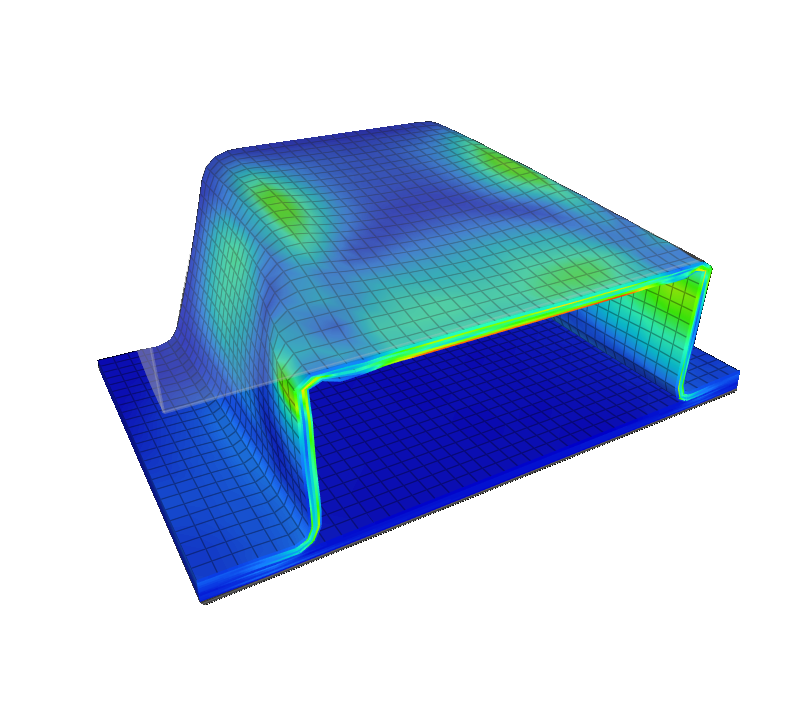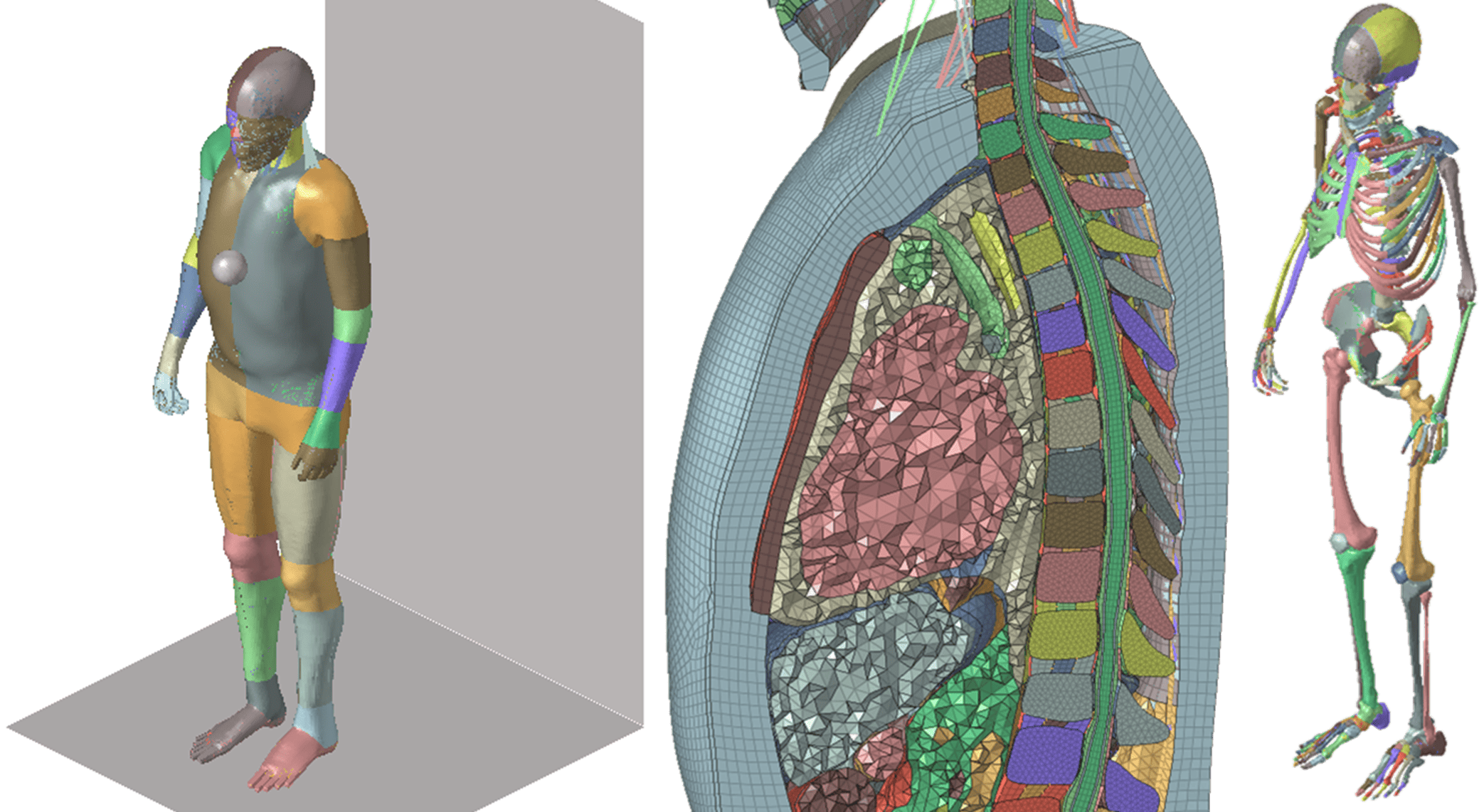How FiniteNow Works: Getting Quotes for your Simulation in Minutes
Getting your simulation project started is straightforward. Our guided workflow captures the essential technical details step by step – from defining your project scope to receiving a transparent proposal. Each section focuses on the information that matters most for accurate and efficient analysis, so you can move from concept to results without unnecessary overhead.
How we run Durability and Fatigue Analysis Projects
Durability and fatigue analysis focuses on predicting the lifetime of components and assemblies subjected to cyclic loading. Unlike static strength checks, fatigue simulations assess how micro-cracks initiate and propagate over time, leading to eventual failure. With advanced finite element analysis (FEA) services, engineers can design safer, lighter, and longer-lasting products while reducing the cost and time of physical testing.
At FiniteNow.com, durability and fatigue analysis is performed using industry-grade FEA workflows tailored for metals, composites, and hybrid materials. By combining instant project quoting, scalable engineering teams, and cost-efficient delivery from pre-audited simulation providers, FiniteNow ensures fatigue simulations are accessible, fast, and reliable.
Durability Simulation: Thinking longterm.
The main goal of fatigue analysis in structural simulation is to estimate how long a part will last under real-world cyclic loads. While static FEA can confirm a design does not fail under peak stresses, durability simulation goes further by calculating crack initiation, crack growth rates, and lifetime under variable load spectra.
Typical targets include:
- Predicting fatigue life under constant amplitude or random loading.
- Identifying weak spots and stress concentrators where cracks are most likely to form.
- Improving durability by design optimization, such as geometry adjustments or surface treatments.
- Supporting certification requirements, e.g., in aerospace and automotive, where fatigue validation is mandatory.
For engineers, durability simulation is not only about preventing failures, but also about enabling weight reduction and cost efficiency by using materials to their maximum potential without compromising safety.
How we approach Fatigue and Durability
Linear elastic FEA is often sufficient to calculate stresses for early fatigue screening. However, for components with local plasticity, nonlinear analysis is required to capture strain ranges accurately. Nonlinear finite element analysis provides better estimates for low-cycle fatigue, where materials yield repeatedly. Experienced analysts often combine both approaches, using linear FEA for global screening and nonlinear simulations for critical hot spots.
Durability analysis can be conducted in the time domain using actual load histories, such as road load data or service load spectra. Time-based fatigue analysis accounts for variable loading and sequence effects, which are critical in automotive or wind turbine components. Frequency domain methods, on the other hand, allow faster evaluation under random vibration loading. Engineers often switch between time and frequency domain FEA depending on the application and test data availability.
Most fatigue analyses rely on implicit solvers, as the stress history is evaluated under quasi-static conditions. However, explicit solvers become necessary when components are subjected to impact, crash, or transient loads, which may accelerate fatigue damage accumulation. For expert users, combining implicit and explicit analyses in a single workflow allows both global durability checks and local transient effects to be captured.
Material modeling is critical in fatigue simulation. Metals are often evaluated with S–N curves (stress-life), while strain-life (ε–N) methods are applied when plasticity dominates. Composites require progressive damage models, accounting for matrix cracking and fiber breakage. Experts integrate environmental effects, such as temperature and corrosion, into fatigue material data, ensuring simulations capture real service conditions.
Stress concentrations at notches, welds, or fillets are the most common fatigue initiation sites. High mesh resolution in these regions is essential to capture local stress gradients. Advanced workflows may combine global–local modeling: coarse FEA models for overall load distribution, refined submodels for fatigue hot spots. Mesh refinement studies are crucial to ensure convergence of fatigue results.
Fatigue often interacts with thermal, fluid, or vibration phenomena. Thermal fatigue occurs in engines and electronics due to repeated heating and cooling cycles. Corrosion fatigue involves chemical degradation combined with cyclic stress. Fluid–structure interaction simulations may be required to model fatigue in turbines, propellers, or biomedical implants. Advanced multiphysics FEA provides realistic predictions for these complex cases.
Deterministic fatigue analysis provides a single life estimate for a given load spectrum. However, variability in material properties, manufacturing defects, and load histories means probabilistic fatigue analysis is often more realistic. By simulating many scenarios, engineers obtain life distributions and reliability curves. These insights support risk-based design decisions and safety certifications.
1D beam models may be sufficient for early durability checks, but 2D and 3D FEA models are required for complex geometries with multiple stress raisers. Shell elements capture weld seams efficiently, while 3D solid elements are necessary for local crack initiation studies. Advanced fatigue workflows integrate crack propagation simulations using XFEM or cohesive elements.
Frequency domain fatigue analysis is efficient for vibration-driven fatigue, such as in aerospace structures or electronic assemblies. Time domain analysis is better suited for variable amplitude road loads, wind spectra, or operational histories. Engineers often calibrate frequency domain fatigue predictions against time-domain simulations to validate their accuracy.
Modern fatigue analysis is increasingly automated. Engineers can link durability simulations with design optimization algorithms to minimize weight while maintaining target life. Automated workflows can scan multiple load spectra, materials, and geometries to identify the most durable configurations. This reduces manual iterations and speeds up decision-making in product development.
Solver strategies depend on whether the goal is life prediction or crack propagation. Stress–life and strain–life fatigue use implicit static solvers, while fracture mechanics–based fatigue may require nonlinear transient solvers. Hybrid workflows combine both approaches, ensuring accurate predictions across different fatigue regimes.
Most fatigue FEA assumes continuum damage accumulation until a predefined crack initiation point. Discrete crack modeling, such as XFEM or cohesive elements, explicitly simulates crack initiation and growth. Advanced workflows integrate both methods: continuum FEA for crack initiation, followed by discrete crack growth modeling to estimate residual life.
How we Avoid Typical Mistakes in Duability Analysis
One common mistake is relying solely on static stress results to estimate fatigue life, without considering load spectra or material strain ranges. Another is neglecting mesh refinement at notches or welds, leading to overly optimistic fatigue predictions. Many engineers also overlook environmental influences such as corrosion, which can drastically reduce durability.
To avoid these pitfalls, engineers should always calibrate simulations with experimental fatigue data, apply appropriate material models, and validate results with physical testing when possible. Automated workflows and sensitivity studies can further reduce uncertainty. Leveraging expert FEA services, like those at FiniteNow.com, ensures best practices are applied consistently across projects.
Use Cases for Fatigue
Automotive – Suspension Component Fatigue
Suspension arms and brackets experience millions of cycles under variable road loads. FEA-based durability analysis ensures they last the vehicle’s lifetime without cracking. By combining road load data with fatigue simulations, manufacturers reduce warranty claims and optimize weight.
Aerospace – Wing and Fuselage Durability
Aircraft wings and fuselage panels are exposed to cyclic pressurization and aerodynamic loads. Fatigue simulation with FEA helps predict crack initiation in riveted joints and composite laminates. This enables predictive maintenance schedules and compliance with strict aviation regulations.
Energy – Wind Turbine Blade Fatigue
Wind turbine blades are subjected to highly variable wind loads, leading to cyclic stresses in composite materials. Finite element fatigue simulations assess durability under both aerodynamic and gravitational loads. Accurate predictions extend service life and reduce costly downtime.
Learn more about our portfolio of Structural Engineering Services
FAQ: Durability and Fatigue Analysis with FEA Services
Fatigue analysis is the process of predicting how many load cycles a component can withstand before failure occurs. Unlike static strength checks, fatigue simulations consider repeated loading that may cause cracks over time. Engineers use FEA to identify weak points and extend component lifetime. For newcomers, it is often the first step toward reliability-driven design.
A part may withstand a single maximum load but fail after thousands of smaller, repeated loads. Durability simulation ensures a design survives its entire service life under realistic operating conditions. This is particularly critical in automotive, aerospace, and energy applications where long-term reliability is essential. Static strength is necessary, but durability is what prevents in-service failures.
Automotive, aerospace, civil engineering, and energy sectors all depend heavily on durability analysis. Each industry has strict lifetime requirements, ranging from millions of road cycles in cars to 20+ years of service life for wind turbines. Finite Element Analysis Services provide a cost-effective way to meet these demands before physical testing begins.
The stress-life (S–N) method is used when stresses are within elastic limits and high-cycle fatigue dominates. The strain-life (ε–N) method is applied when plastic strains are present, as in low-cycle fatigue. Advanced engineers often combine both methods depending on component hot spots, using FEA to provide local stress or strain histories. This flexibility allows more accurate durability predictions across loading regimes.
Welds, sharp corners, and notches act as stress concentrators, dramatically reducing fatigue life. Without proper modeling and mesh refinement, FEA may underpredict damage in these areas. Intermediate engineers often apply hotspot methods, structural stress approaches, or local submodels to capture weld durability. Fatigue FEA services provide specialized techniques for these critical details.
Real-world loading is rarely constant. Engineers use rainflow counting and cycle counting techniques to convert irregular load histories into equivalent cycles. Time-domain fatigue simulations then apply these load histories to the FEA model. This ensures durability predictions reflect real operational conditions instead of idealized assumptions.
Senior analysts combine fatigue initiation analysis with fracture mechanics–based crack growth simulations. Using stress intensity factors (ΔK) and crack propagation laws, FEA predicts residual life after crack initiation. This integration is vital for safety-critical structures like aircraft fuselages, where inspection intervals depend on accurate crack growth prediction.
Thermal–mechanical fatigue, corrosion fatigue, and fluid–structure fatigue require combining mechanical loading with additional physics. These simulations demand advanced solver strategies and validated multiphysics material data. For experts, multiphysics fatigue is often the frontier where traditional fatigue approaches meet cutting-edge research.
Experts increasingly use probabilistic FEA to quantify fatigue life scatter due to material variability and load uncertainties. Monte Carlo or stochastic methods generate statistical lifetime distributions, which regulators often require for aerospace certification. This goes beyond deterministic safety factors, providing more robust safety margins.
FiniteNow.com offers instant quoting, enabling engineers to start durability projects without lengthy procurement delays. Its network of pre-audited providers ensures high-quality results while maintaining cost efficiency. By offering scalable teams of fatigue experts, FiniteNow matches project size and complexity with the right resources. This combination makes it a unique FEA service provider.
FiniteNow.com uses standardized workflows, validated fatigue libraries, and a pool of senior FEA specialists to maintain consistency. Clients benefit from both speed and technical depth, since projects are reviewed by engineers with domain-specific expertise. Unlike freelance-based platforms, FiniteNow ensures quality through vetted partners and internal checks.
Yes, FiniteNow’s network includes experts in structural–thermal fatigue, vibration fatigue, and corrosion fatigue. Projects can seamlessly scale from single-component fatigue checks to full multiphysics durability simulations. This breadth of capability means clients can rely on one service partner for everything from basic stress-life fatigue to advanced fracture mechanics.
Start Now! It will only take 12 minutes
It has never been faster, easier and more cost effective to get a quotation for your structural simulation needs:
Looking for more details and background about Fatigue Analysis?
Durability and Fatigue Analysis with FEA
The Textbook Section
Introduction
Durability and fatigue have long been central concerns in structural engineering. While ultimate strength failures are often dramatic and obvious, it is fatigue that quietly governs the service life of most mechanical and aerospace structures. The crack that initiates at a rivet hole, the weld toe that slowly accumulates micro-damage, the rotating shaft that endures millions of cycles before failure – all of these are governed by fatigue mechanisms.
Finite Element Analysis (FEA) has become a powerful tool in this field. Traditional fatigue design relied heavily on empirical data, S-N curves, and conservative safety factors. With modern FE analysis, engineers can go much further: capturing local stress concentrations, simulating nonlinear material behavior, and even predicting crack initiation and propagation under realistic loading.
For organizations offering FEA services, durability and fatigue analysis represent one of the most valuable applications of the technology. It is not just about proving that a structure survives its first load case, but about ensuring that it will withstand millions of cycles in service, under variable environments and real-world usage.
Fundamentals of Fatigue Behavior
Fatigue is not a single phenomenon but a sequence of stages. First comes crack initiation, often at stress raisers such as notches, weld toes, or fastener holes. Then crack growth dominates, with each load cycle extending the crack incrementally. Finally, once the remaining section is too small, final fracture occurs.
In metals, fatigue behavior is typically described by S-N curves (stress vs. number of cycles). For composites, fatigue is more complex, involving matrix cracking, fiber breakage, and delamination. Regardless of the material, local stress and strain are the driving parameters.
FE analysis plays a key role here. By resolving local stresses and strains under cyclic loading, FEA provides the input to fatigue models. What once required conservative approximations can now be quantified with detailed simulation. For example, FEA can identify which rivet in a joint carries the highest load, which weld experiences the most damaging stress range, or which lug radius is most susceptible to crack initiation.
Durability Analysis with FEA
Durability analysis focuses on whether a structure can meet its design life without failure under expected service loads. This requires not only evaluating stress ranges but also considering real-world loading spectra.
In the automotive industry, for example, durability analysis involves simulating entire proving-ground tracks digitally. Suspension arms, brackets, and body-in-white structures are subjected to load histories derived from measured road loads. In aerospace, flight load spectra are applied, often involving thousands of unique maneuver and gust cases.
FEA enables durability evaluation in two complementary ways. At the global level, system-level FE models determine load distribution across components. At the local level, submodels capture detailed stresses in fatigue-critical features. This “global-to-local” approach is essential: without the global model, loads cannot be correctly distributed; without the local model, stress concentrations cannot be resolved.
Modern FE services frequently integrate durability analysis with multi-body dynamics (MBD) simulations. For example, an automotive suspension system may be represented with flexible FE models of control arms connected to an MBD vehicle model. The interaction between road loads, dynamics, and structural stresses can then be evaluated over millions of cycles, providing a realistic picture of durability performance.
Fatigue Analysis Strategies in FEA
There are several well-established approaches to fatigue analysis within FEA, each suited to different levels of fidelity and computational cost.
1. Stress-Life (S-N) Approach
This is the most widely used method, particularly for high-cycle fatigue. Local stress ranges are extracted from FE results and compared against S-N data for the material. Mean stress corrections may be applied (e.g., Goodman or Gerber).
The method is efficient but assumes that damage is governed by stress amplitude, not strain.
2. Strain-Life (ε-N) Approach
When low-cycle fatigue is relevant, such as in components subject to high plastic strains, the strain-life approach is more accurate. FEA must then resolve local plastic strains, and cyclic plasticity material models may be required.
The Coffin-Manson relation is often used. This approach is common in engines, pressure vessels, and thermally loaded structures.
3. Fracture Mechanics Approach
For components where cracks are expected or already exist, fracture mechanics is used. Instead of predicting when cracks will start, this approach predicts how fast they grow. FEA is used to calculate Stress Intensity Factors (SIFs)
or energy release rates, and crack growth laws such as Paris’ law are applied. This is the standard method in aerospace damage tolerance analysis, where cracks are assumed to exist from the outset.
4. Multiaxial and Non-Proportional Fatigue
Real-world loading is rarely uniaxial. Complex structures may experience combined bending, torsion, and shear. Advanced fatigue analysis methods use critical-plane approaches to evaluate fatigue life under multiaxial loading. FE analysis
provides the local stress tensors, which are then processed by fatigue algorithms to predict damage.
Nonlinear Effects and Contact
One of the key strengths of FEA in fatigue analysis is its ability to capture nonlinear effects. Contact conditions, preload relaxation, friction, and material plasticity all influence fatigue performance.
Consider a bolted joint: if modeled linearly, it may appear that each bolt shares load evenly and experiences moderate stress. But with nonlinear contact and preload included, the analysis may reveal that only a subset of bolts actually carry most of the load, and that micro-slip occurs at the faying surfaces. This localized slip is often where fatigue cracks initiate.
Similarly, in welded joints, the nonlinear redistribution of stresses around the weld toe under cyclic loading may determine the effective hot spot stress. Without nonlinear FEA, such redistributions are lost, leading to unconservative fatigue predictions.
Material Modeling for Durability
Accurate fatigue predictions depend on accurate material models. Metals, composites, and elastomers each require different treatment.
For steels and aluminum alloys, S-N or ε-N curves are widely available. However, scatter is large, and environmental effects such as corrosion or temperature must be accounted for. In composites, fatigue modeling is more complex. Matrix cracking, fiber fatigue, and interlaminar delamination interact in non-linear ways. Cohesive zone models and progressive damage models in FEA are increasingly used to capture these mechanisms.
Elastomers, often used in flexible joints and vibration isolators, exhibit hysteresis and rate-dependent fatigue. Viscoelastic and hyperelastic models in FE solvers can reproduce these behaviors, but calibration against experimental data is mandatory.
Applications Across Industries
In aerospace, fatigue analysis with FEA underpins the entire philosophy of damage tolerance. Components such as lugs, riveted joints, and bonded repairs are analyzed not only for static strength but also for crack growth behavior. Certification authorities require that safe life or fail-safe criteria are demonstrated using validated FE models.
In automotive engineering, fatigue and durability analysis drives design of suspension systems, engine mounts, and welded body structures. Virtual proving grounds are now routine, with FE durability analysis saving enormous cost and time compared to physical prototypes.
In heavy machinery and energy, fatigue governs the life of pressure vessels, pipelines, wind turbine towers, and rotating shafts. FEA enables engineers to model complex load histories and environmental conditions, ensuring reliability over decades of service.
Conclusion
Durability and fatigue analysis with FEA has transformed how engineers design, certify, and optimize structures. By moving beyond empirical safety factors to physics-based predictions, FE analysis allows engineers to understand not just whether a structure is strong enough today, but whether it will still be safe and reliable after millions of load cycles in the field.
Stress-life, strain-life, and fracture mechanics approaches provide a spectrum of methods suitable for different fatigue regimes. Nonlinear effects, contact behavior, and detailed material models allow simulations to capture reality with increasing fidelity. Flexible and damped connections further extend the scope, showing how fatigue analysis is not limited to rigid joints but also to functional connectors that filter loads and vibrations.
For practicing engineers, the art lies in selecting the right method for the problem. Simplified fatigue analysis may suffice for early design screening, while certification-level studies demand detailed nonlinear FE models, calibrated against test data. For organizations offering FEA services, mastery of durability and fatigue analysis is a key differentiator, enabling them to deliver not only structural strength assessments but also full lifecycle predictions.
By combining advanced FEA with sound engineering judgment, it is possible to design structures that are not just strong, but durable – capable of performing reliably over years and decades of demanding service.





